Collections, Informative
Cyclamen Species in Australia
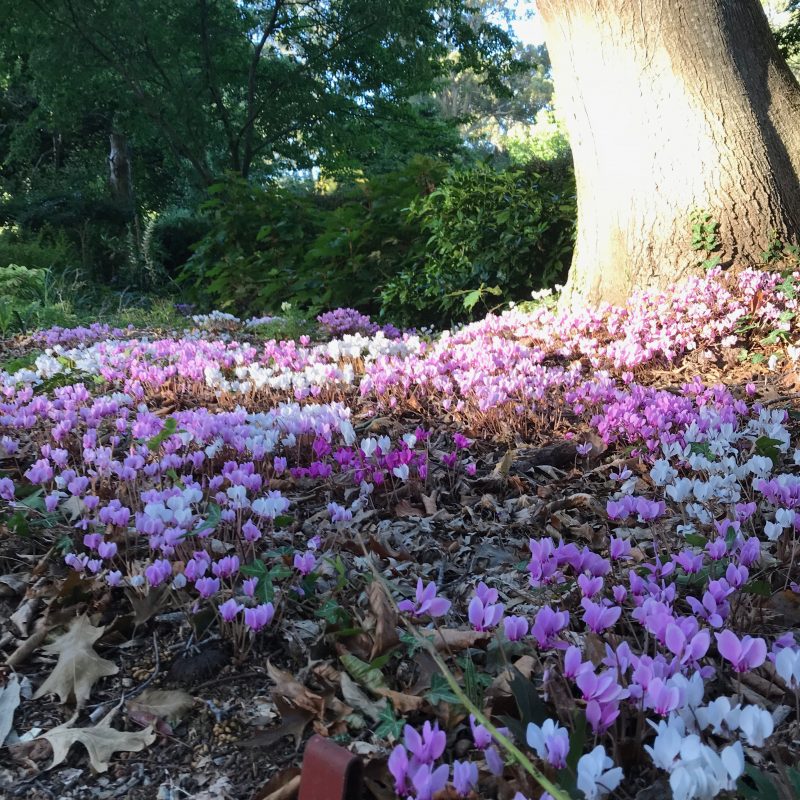
The common florist Cyclamen is very often a benchmark gardeners set for the entire genus. To Judge a genus on the performance of one of its members is often a mistake. The florist Cyclamen we are all familiar with are hybrids from the species Cyclamen persicum. The persicum hybrids flower very young, they’re often short lived and most are not good garden plants with exceptions of course. Other members of the genus behave very differently, many amongst them are very long-lived garden plants.
It is possible with a range of species to have Cyclamen flowering all year round. Spring and Autumn are the main flowering periods but Cyclamen coum flowers all winter and Purpurescens is a summer flowerer
Cyclamen are in the family primulacea, most of them are found around the Mediterranean, the Middle East, in to Southern Europe, Israel and North Africa. Their hardiness in Australia depends on the altitude and latitude they come from. Some species are found at very low altitudes around the Mediterranean making them perfect candidates for our Southern Australian gardens. For those of us who live on and around the great divide the conditions are almost perfect for the vast Majority of Cyclamen species.
These plants are notoriously slow to reproduce, the only way to increase them is from seed and in some cases they may take up to 6 years to flower from germination. For this reason they are not freely available in local nurseries.It is only small specialist nurseries like myself or Dicksonia nursery at Mt Macedon who would take the time to produce these garden treasures. In Europe where there is a large gardening public Cyclamen species are produced by production nurseries and sold in large numbers.
I grow most of the species outlined below but sometimes in very small numbers so its worth enquiring if there is one you particularly want.
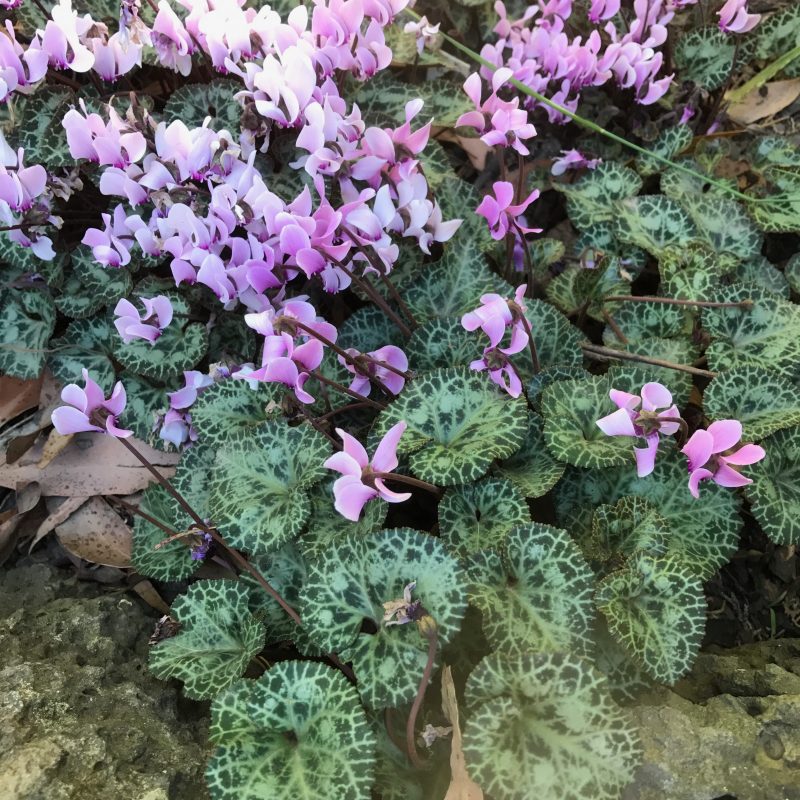
A brief overview of Cyclamen species and their garden worthiness.
Under this heading I am going to outline the species I have experience with and their garden requirements. I will list them in order of suitability and availability.
Cyclamen Hederifolium
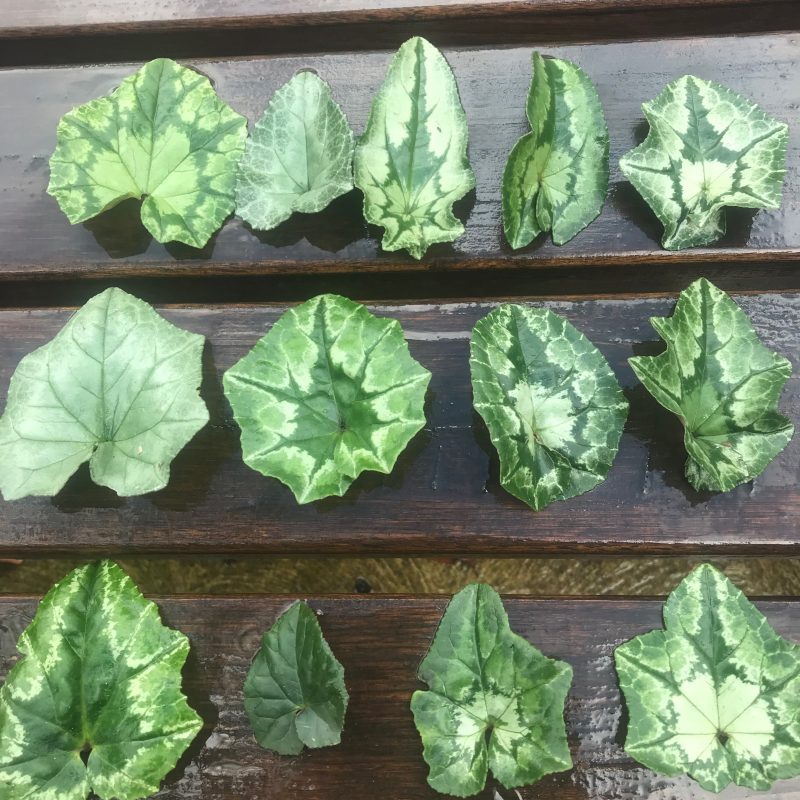
With the exception of Persicum, Hederifolium is the most frequently seen Cyclamen species and for good reason. This Cyclamen’s wide distribution in the wild is indicative of a plant with great garden potential. Being a woodland species deciduous shade is the place where hederifolium will flourish. So best under deciduous trees and shrubs with good humus rich soil and a thick mulch.
Very often when a plant tolerates certain conditions there is an assumption that this plant likes said conditions. Cyclamen hederifolium is a good example. So many times I have heard it said that Cyclamen like their tubers to sit on the soil surface and for some species this is true. However the vast majority including Hederifolium will tolerate sitting on the surface but like to be planted well below. In my experience corms planted too close to the surface will live and grow but the spread, leaf size and flowers from each corm is much reduced whereas corms planted at 10cm deep then mulched will cover a much bigger area with larger leaves and more flowers.
Hederifolium is grown as much for leaf forms as for flowers. As the species name suggests its foliage loosely resembles Ivy in shape but its the leaf patterning that’s of interest and many growers select and breed for leaf pattern above flowers.
The flowers are various shades of pink or white, there are selected forms with very deep pink almost purple
The first flowers appear in mid January initially quite sparse but as the season progresses the number of blooms increases dramatically. Late March into April the first leaves unfurl and there is a period of about 1 month when they carry foliage and flowers together. Once flowering has finished there remains a carpet of beautifully marked leaves until late November when they start going into dormancy.
Do Cyclamen Spread ?
The short answer is yes however there is a long answer as well. Most species set copious amounts of seed, hederifolium being the most abundant. Some seed is spread by ants but the majority germinates very close to the parent corm. Most of these seedlings are shaded out by larger leaves and die. Some of them will survive and develop right on top of an old corm, piles of corms are very common in drifts and they seem to like growing in these congested conditions. The little seedlings are easily lifted and planted away from their parent, I plant them in clumps of 3-4 so they won’t be lonely. This is the best way to develop a significant drift. Left to their own devices the spread will be slow.

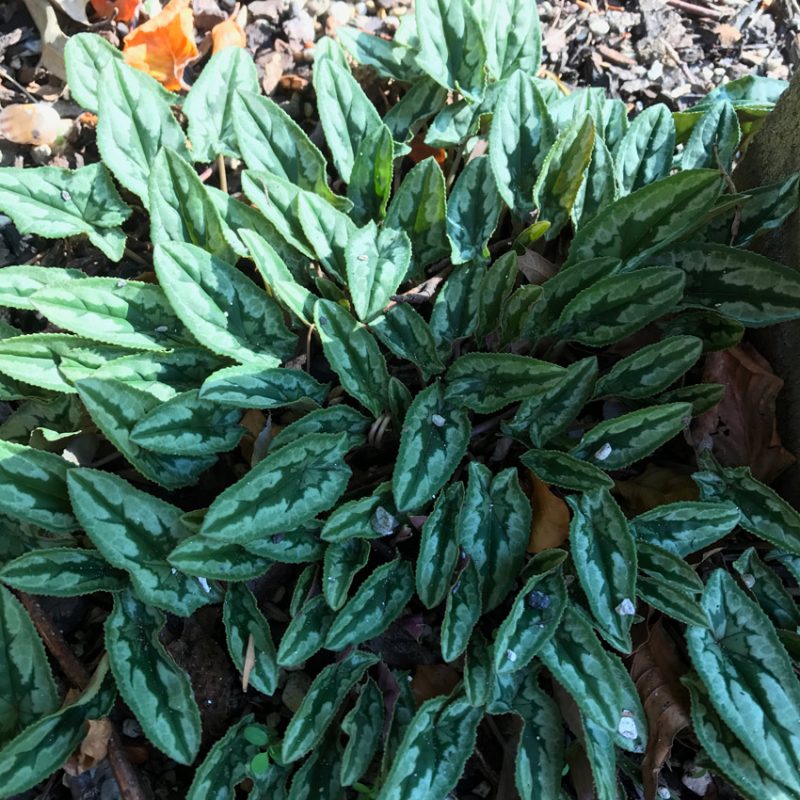
Cyclamen graecum
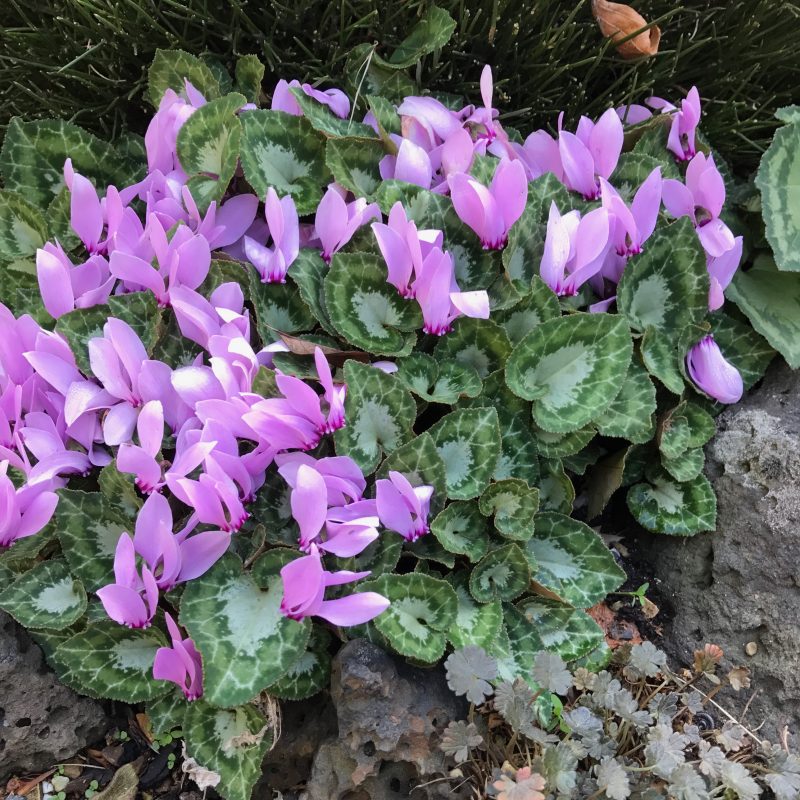
This is a species which should flourish in both lowland and hill country gardens.Native to southern Greece, Turkey and associated islands. It is an oddity in the genus in that it likes full sun and the tubers require a very long dry dormancy. It should be grown with excellent drainage and in full sun. This species has an extensive root system so if pot grown should be put into a tall narrow pot. The corms can live to a great age and will become enormous producing large quantities of flower and leaf.

Cyclamen graecum in my experience does not self seed as freely as some species so increasing will require seed collection and pot raising. There is no difficulty germinating seed in pots. For keen gardeners this species should be on top of your list. A relatively short Autumn flowering season is more than compensated for by the beauty of its foliage which is said to be one of the most beautifully patterned in the genus.
How to feed Cyclamen.
Just a quick word on feeding ground grown corms, pot grown plants will be dealt with under that heading. Cyclamen grown in the ground don’t seem to require much feeding if they’re grown in hummus rich soil and are mulched often. Some species like slightly alkaline soil so liberal applications of dolomite will increase vigour.
Cyclamen africanum
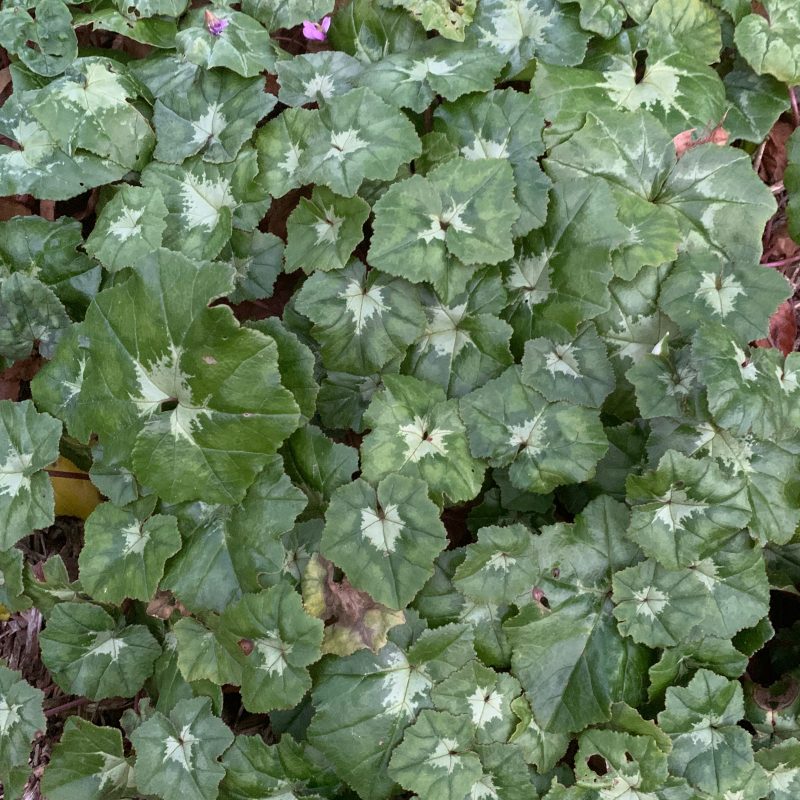
Easily mistaken for hederifolium, Cyclamen Africanum has some differences, I have often seen the odd plant amongst large populations of hederifolium and it will hybridise with this species. The flowers of africanum are held directly above the corm and do not spread out as hederifolium does. Its foliage is large and leathery without the variation in patterning associated with hederifolium. Coming from North Africa it does not tolerate frost. I grow africanum hard up against tree trunks where it will dry out over summer and has a very restricted root run. Another one which does not self seed freely in the garden. The tubers have with age the capacity to grow very large easily reaching 25cm diameter. The flowering season is Autumn ,colour soft pink. Summer dormant
Cyclamen persicum

This is a species often overlooked by collectors because of its association with the florist strains that are produced in such large numbers. The species however is a very good plant, it has a wide distribution around the Mediterranean, Middle East and North Africa where it grows in quite hash rocky conditions. Persicums preference for a very long dry summer dormancy should make it easy to cultivate in many Australian gardens. I grow my plants in pots and they are put under cover and not watered at all during dormancy until new growth appears in Autumn. The flowering period is from mid winter until mid spring and even then the plants must dry out between watering. Flower colours are variable ranging from mid to soft pink and white with a deep magenta band at the base.
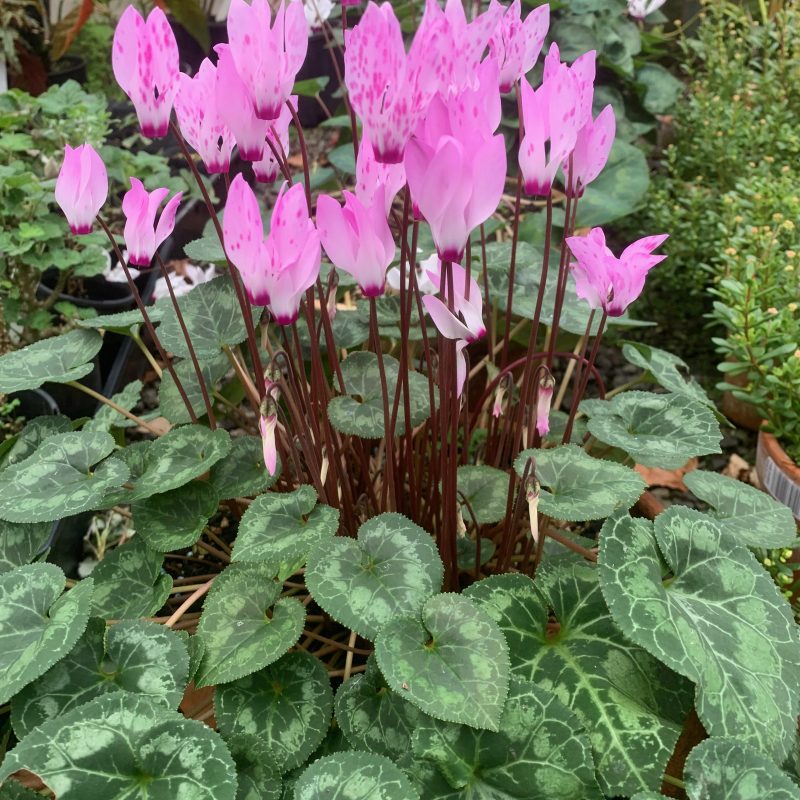
This is potentially a very long lived plant. My corms are now 22 years old raised from wild collected seed. The plants I sell are all the offspring of these corms.
Cyclamen coum
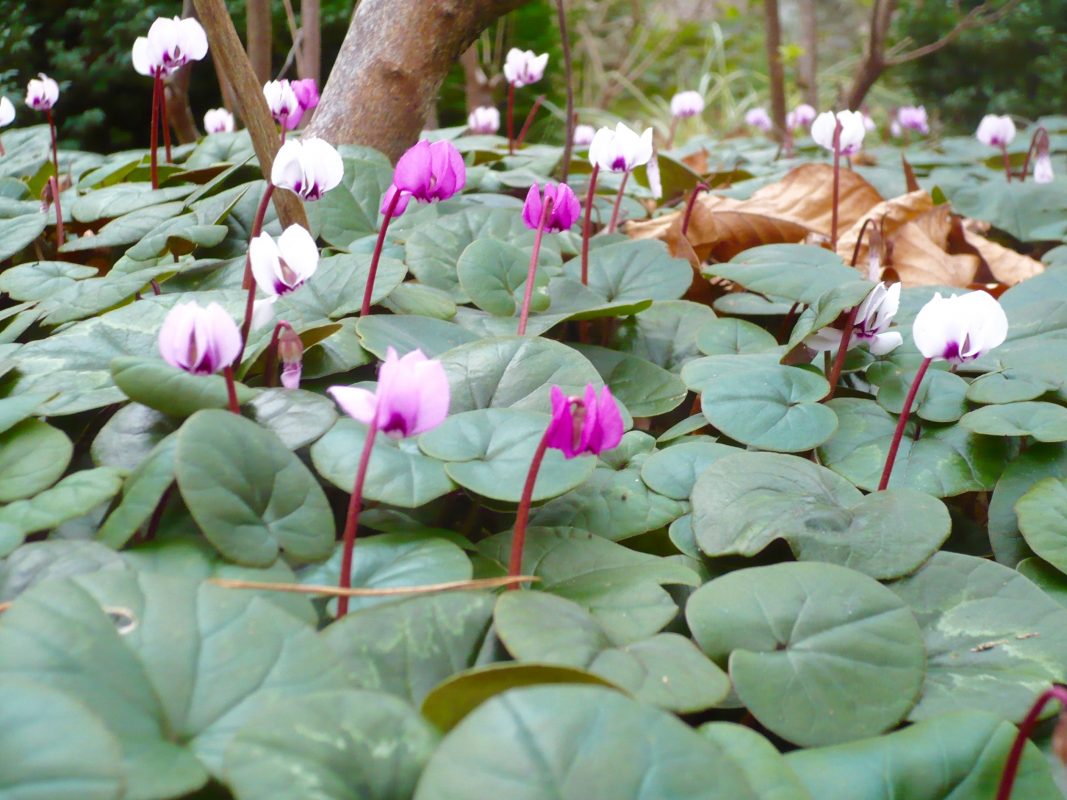
Cyclamen coum is one of the beauties of the winter garden. The first flowers appear in mid June and continue through till mid October. Its natural habitat is around the Black Sea, Northern Turkey, the Caucasus and Crimea. It is not a plant for hot districts the corms need to be kept cool and a little moist during dormancy. I have seen it naturalised in well tended Melbourne gardens where it is grown in deep deciduous shade. Here in the hills it flourishes self seeding abundantly and eventually forming large drifts.
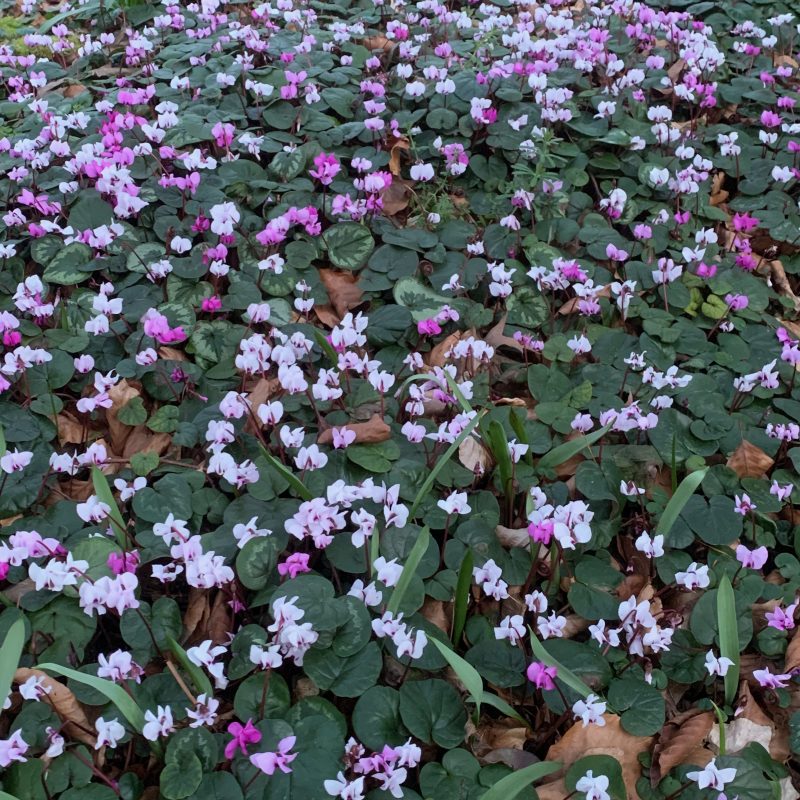
This is a species that has had considerable hybridisation and selection work done with it so there is an abundance of leaf and flower colour forms. It is very much a woodland plant so should be grown in good leafy soil beneath deciduous trees and mulched frequently. The corms should be planted 10cm deep. Most Cyclamen and coum in particular are very sociable plants, they like to grow in dense communities with the tubers stacked on top of each other in wild profusion. It is a small plant the corms even with great age only reaching a 10-12cm diameter.
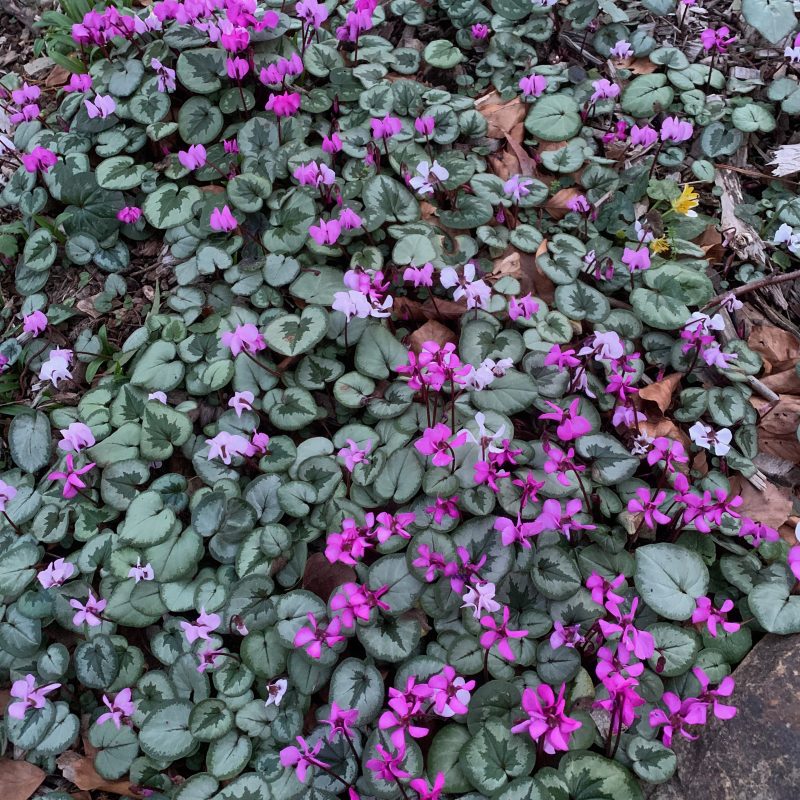
Drifts of all Cyclamen species take time and effort to create, the corms do not increase but only multiply by seeding. Seedlings will take 4-6 years to flower. The most efficient way to make drifts is to collect seed and raise it in pots. Fresh seed has a very high viability so its easy to raise large numbers. Once germinated leave the seedlings in their pots for a couple of years until the corms have changed from a translucent colour to brown or when they have a minimum of two leaves, then plant them out at 10cm spacings.
Cyclamen repandum
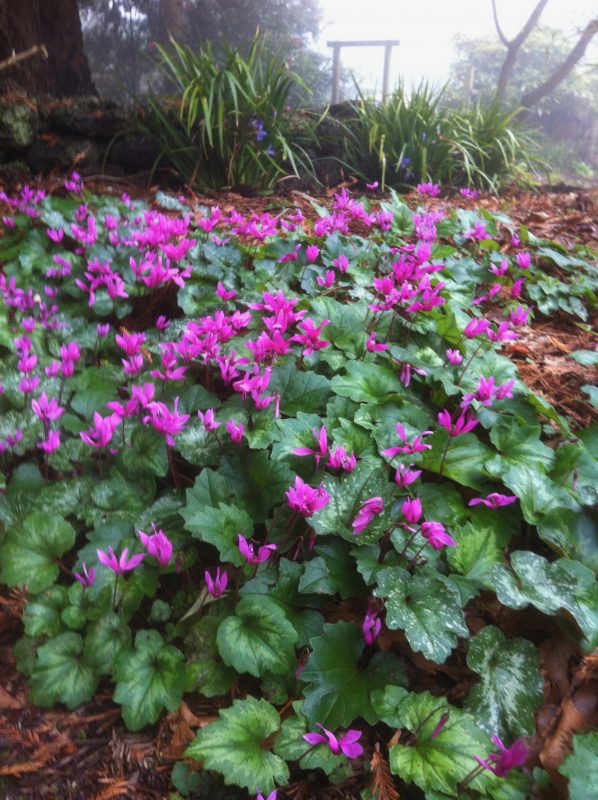
Repandum is the last Cyclamen to flower in spring, the leaves appear in late winter and flowering is October, November. This is a woodland plant native to Bosnia, Croatia, The Balkans and some Mediterranean islands. It requires a cool leafy position and copious winter rainfall. Repandum is a species with very little variation in leaf or flower although there is a rare white form in cultivation. It has naturalised in my garden where the corms settle themselves very deep in the soil. I have not seen it grown in lowland gardens but see no reason why not if given a cool position with good hummus rich soil.
Cyclamen pseudibericum
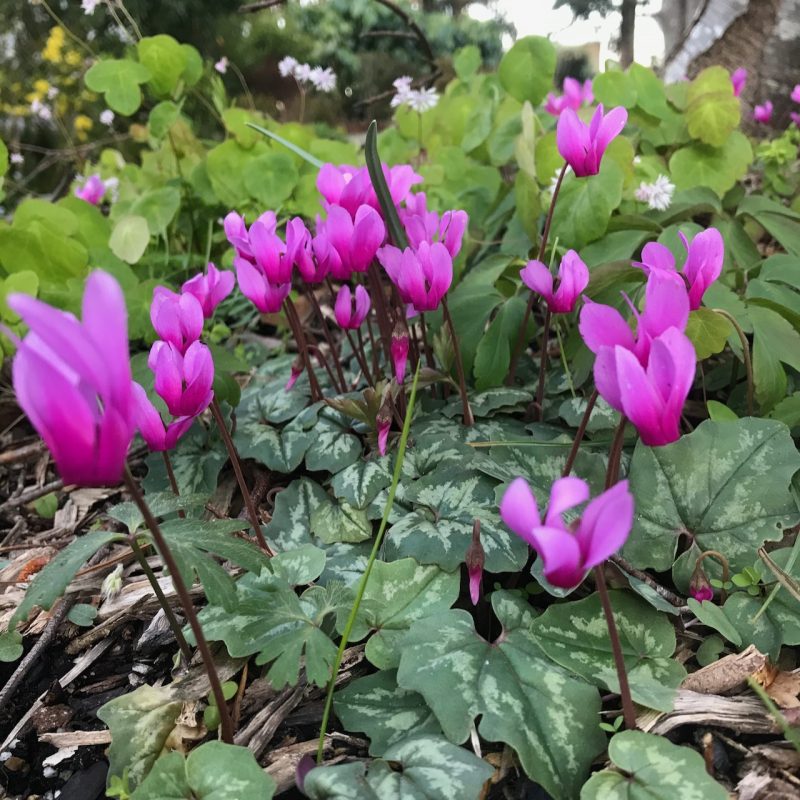
A species that is endemic to the north easter corner of the Mediterranean where it grows in deciduous and pine forests. This species does not vary much in leaf pattern or flower colour. The flowers are a deep carmine pink and emerge in very early spring and look beautiful combined with Anemone blanda. I have no problem growing pseudibericum in my garden where it self seeds lightly in deciduous shade. In the lower left corner of the photograph you will see seedlings on the edge of the main clump, these seedlings will take a few years to mature and flower.
Cyclamen purpurescens
Purpurescens is not commonly available in Australia, I only occasionally have plants to sell, its very much a cool climate plant so is restricted to hills gardens. This is a species which is extremely slow to increase, self seeding is sparse and the seed capsules are small and difficult to locate. The beauty of this species is its summer flowering which extends the range of this genus beyond the usual Autumn Spring flowering period. A wood land species purpurescens needs leafy soil in partial shade and will not tolerate summer dry. In Europe this is a much coveted plant its one of the few which will naturalise in Northern hemisphere gardens so there has been some hybridisation work done.
Cyclamen libanoticum
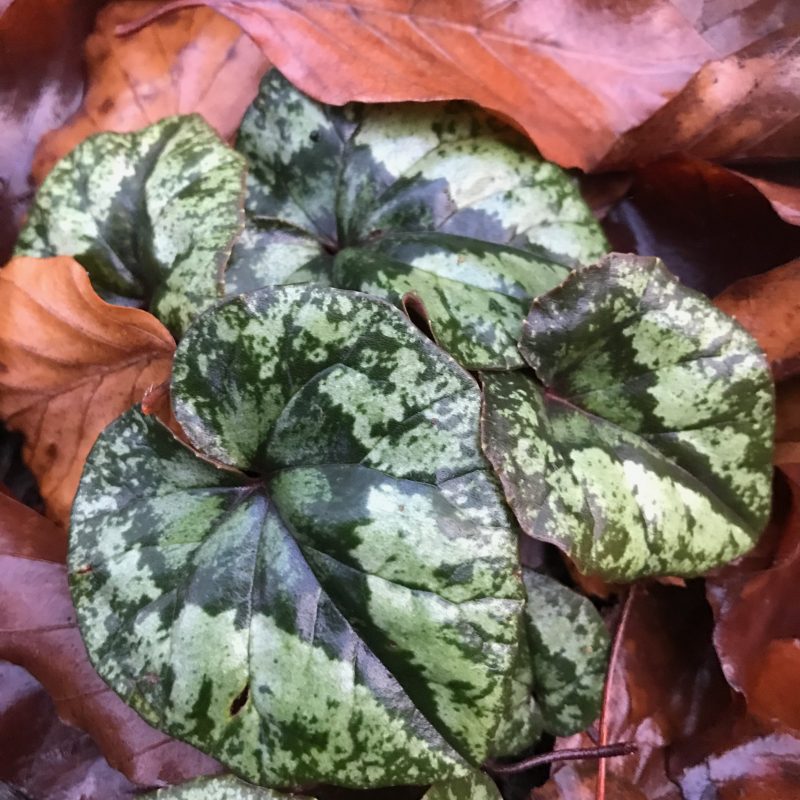
From the Mountains of Lebanon this species is close to extinction in the wild as a result of over collection of wild tubers. Libanoticum does very well in my Olinda garden where it has been growing for many years. It self seeds lightly although the seedlings take many years to mature. This species has a sparse habit with few leaves and few large soft pink flowers. I think that it would take many tubers to make a dense carpet, only time will tell. The Mountains of Lebanon are limestone so the addition of dolomite is beneficial to this species
Cyclamen species in pots
The cultivation of Cyclamen species in pots is all about controlling watering, especially during their dormancy. They are really best grown under cover in a cold frame, unheated glass house or even under the eves of your house..
They like to be tight in their pot so do not over pot or repot too often. As stated earlier they really enjoy company so more than one corm per pot helps. Smaller species such as intaminatum, coum or mirable could have as many as 6 corms per pot.
The potting mix should be free draining and gritty, a third of the mix could be horticultural pumice. The corm can sit on top of the potting mix then be covered with 3cm of pumice or some form of grit.
They can be fed during the growing season with both a small amount of slow release fertiliser and regular foliar feeds. Stop feeding when their foliage is in decline and during dormancy. Feeding commences with the first sign of growth.
Most plants are lost during dormancy, this is usually due to damp which causes the corms to rot. So during this period the pots are best stored in a cool dry place and watered perhaps once or twice. Even over their growing season allow the pots to dry out between watering. It is best to understand the species you are growing particularly the climate in which they originate and water accordingly.
In Conclusion
There are many other Cyclamen species and hybrids between species not covered here and most of them are grown by collectors here in Australia but most are seldom if ever grown commercially.
In a world dominated by instant gratification and gardening makeovers it is for me refreshing to grow such a slow species. Patience is integral to gardening, all the very finest plants are slow growing, this genus epitomises that theory. The satisfaction of developing even small drifts of Cyclamen is immense. I have a small drift of patterned leaf cyclamen coum and each year I prick out seedings close to the parent and spread them so gradually moving the drift outwards.
The very best species to start out with is Cyclamen hederifolium, its almost bullet proof and if established in a position under deciduous trees and shrubs or in light shade will naturalise easily but slowly.
So often I have customers baulk at the price of these plants, these are people who don’t have an understanding of the time it takes to produce them. Customers see them growing in large numbers around my nursery and make the assumption that this is a plant which spreads quickly and easily.
Both Hederifolium and coum I have in large number and if you are wanting to purchase these corms in numbers you can ask about me supplying them bare rooted freshly dug from the garden. Hederifolium is best moved just after flowering in late autumn or over the winter. Coum mid to late Autumn. In y experience Cyclamen corms establish best when moved during their growing season. Corms moved during dormancy take longer to establish.


I was an avid grower of a large number of Cyclamen species when I lived in the UK. I had huge drifts and large pots of libanoticum, africanum and graecum. I then moved to New Zealand but am now retired in Armidale NSW. I am very keen to purchase plants and seeds of Cyclamen hederifolium, graecum, africanum, persicum, coum, repandum, pseuibericum, purpurascens and libanoticum. Can you assist?
Hi Charles, 2 years ago I had a monumental disaster with my cyclamen species in pots. They were outside under the trees over summer and it rained all season. About 250 pots rotted. Many different species. A harsh lesson. I do have many more coming on but they’re not as advanced. At present I can supply you with 3 yrs old corms of Graecum,libanoticum,pseudibericum and Africanum. Hederifolium and Coum I have in abundance.
Regards
Craig
Hello Craig, I have a particular love for cyclamens (have been growing “florist” cyclamens for years including from seeds but became upset and frustrated with their survival rate.
So, I decided to try the wild varieties and this is how I found your nursery and made a few purchases.
We bought from you one Cyclamen Hederifolium at the beginning of this year (it turned out to be an albiflorum). I flowered prolifically, then produced masses ofleaves and now is clearly going into dormancy. It is growing in a 21 cm diameter pot. Hence the question: how do I care for this cyclamen during dormancy? Should I stop watering it completely like cyclamen persicum?
Later on we also bought from you three young cyclamen persicum (two of them blossomed, one is very fragrant!) I planted them in 11-12 cm diameter pots. I know that florist cyclamens prefer tight potting but was not sure if it applies to the wild persicum. Please advise me if I should change the pots.
Using this opportunity, I would like to thank you for so carefully packed plants. It also impressed me that in the case of my three cyclamen persicum you chose the plants with different leaf patterns (the flowers of two proved to be different aswell).
Yet another question: which other wild varieties have grow well in pots?
Regards,
Anna
Hi, I am looking to add cyclamen species to my garden. Do you have Hederifolium and Coum for sale?
Thank you in advance,
Chamini
Hi, I was given a cyclamen by an elderly friend 18 months ago who pulled a piece from the side of her plant which was growing in a pot. There appears to be no bulb/tuber but I’m not game to pull it out and search for one and risk killing it. It’s a beautiful maroon color. I’ve had it for over 18 months in a pot and repotted it last spring, I liquid feed it every 2-3 weeks and it has never stopped flowering. It’s a miniture form and I’d love more of the same type but I’ve searched and read all the info I can find on line but still have no idea what type of cyclamen I have. Can you advise please.
Hi Christine,
My guess is that you have a form of Cyclamen persicum, the florist Cyclamen. There must be a tuber to sustain the plant otherwise it would have shrivelled very quickly.
The only way to increase Cyclamen is by seed which is best sown fresh. You will see the seed capsules, they coil down like a spring and sit on top of the tuber. If you gently squeeze the capsule and it pops open then the seed is ripe. Cyclamen;amen persicum often self seed in their pots which must be how you’re friend obtained a spare.
I hope this helps